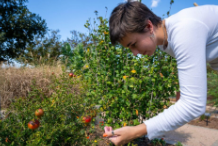Straw bale gardening is an innovative approach to overcome traditional obstacles in the garden. Using a straw bale as a natural raised bed allows gardeners with little to no in-ground space to raise a variety of annual crops. This technique requires a bit of preparation and as with many aspects of gardening, learning tips from more experienced gardeners can be useful.
” Ensure you are using straw and not hay to avoid introducing weeds
” Use the “small” straw bales that are about 2-feet high by 3-feet long
” Place the bales on the narrow edge so the twine is not in contact with the ground to prevent it from rotting and releasing the bale
” Place the bale where it will be planted prior to conditioning. Once conditioning begins it is difficult to move the bale. 
Bale Conditioning
Conditioning is the process of preparing the bale for planting by encouraging the bale to begin decomposing. This creates a healthy base for plant roots to be established and grow throughout the season.
” Water the bales and keep them wet for three days. The bale will heat up as decomposition occurs.
” On days 4, 5 and 6, sprinkle fertilizer on top of each bale with 1 cup of ammonium sulfate (21-0-0) or ½ cup of urea (46-0-0). Water in the fertilizer. This speeds up decomposition.
” On days 7, 8 and 9 continue to sprinkle fertilizer on each bale but reduce the amount by half.
” Water the bale on day 10 (no fertilizer) and begin to monitor the bale temperature. When the temperature drops below 100 degrees F it is ready to plant.
Planting
” Pocket method: Make a hole for each plant several inches deep into the top of the bale. Fill the hole with growing medium and plant.
” Flat Bed Method: Cover the top of the bale with 3 to 4 inches of growing medium (well-aged manure, compost or potting soil) – This method works well for planting seeds.
Number of Plants per Bale
” Cantaloupe: 2
” Cucumber: 3-4
” Peppers: 3-5
” Squash (winter): 2
” Squash (summer): 2-3
” Tomatoes: 2-3
Watering
Straw bales dry out quickly so regular watering is essential for successful crops. A drip system set on a timer can be a good solution.
Some of this information was taken from a publication put out by Washington State University.
Cynthia Domenghini, Extension Agent




